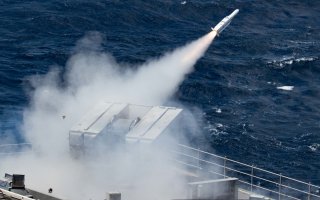These 5 Navy Systems Could Be Key to Victory in Future Wars
Navies that don’t evolve are doomed to defeat, and America is no exception.
Here's What You Need to Know: American supremacy should not be taken for granted.
The U.S. Navy has been the most powerful naval force in the world since 1943. But that supremacy is being challenged as Russia, and especially China, field ever-more sophisticated systems, including aircraft carriers, quiet submarines and hypersonic missiles.
Navies that don’t evolve are doomed to defeat, and America is no exception. But the U.S. Navy has a plethora of new equipment on the drawing boards, the shipyards and the factories.
Here are five key systems that will give the U.S. Navy an edge well into the 21st Century.
1. Ford-class aircraft carriers:
Technically, Ford-class carriers are not a future weapon: the first ship in the series, the eponymous USS Gerald R. Ford, was launched in 2013 and commissioned in 2017. It will be followed by two more ships.
These are the largest aircraft carriers in the world, 100,000-ton behemoths bigger even the Nimitz-class nuclear-powered carriers that are the current backbone of U.S. naval power. With a price tag of more than $13 billion each, these vessels are not cheap, but they are powerful. They have an air wing of 90 aircraft, some of which will likely be unmanned aircraft someday. Compared to the Nimitz carriers, the Fords have better sensors, a more sophisticated catapult launch system, and more powerful nuclear reactors that can supply triple the voltage of older carriers.
2. Columbia-class ballistic missile submarine:
The Columbia-class subs will replace the Cold War Ohio-class vessels, with the first sub slated to begin construction in 2021. Like the Ohios, the Columbias will carry Trident II nuclear missiles, though 16 rather than 20 missiles (note that even with 16 tubes, a single Columbia could pretty much destroy Russia and China as advanced societies). The nuclear-powered Columbias will be stealthier than their predecessors, with a quiet electric-drive propulsion system.
3. Hypersonic missiles:
Exactly what these missiles will look like, and what they'll do, remains to be determined. But just like Russia and China -- or prompted by Russian and Chinese hypersonic -- the U.S. Navy will be getting hypersonic missiles (defined as rockets that travel at Mach 5 or faster).
The Navy recently awarded a $13 million contract to develop guidance systems for hypersonic weapons fired from Columbia-class submarines. Most likely, the Navy's hypersonics will be some sort of boost-glide vehicle, where a missile -- Russia uses ICBMs as boosters -- lofts a glider high into the atmosphere but short of outer space, where it glides down on to its target at a terrifying speed (as fast as Mach 20) that makes them hard to intercept. These may be strategic weapons that can destroy key enemy installations, or tactical ship-killers, but they will transform naval warfare.
4. Large Surface Combatant:
The U.S. Navy's Cold War ships, such as the Aegis cruisers and Burke-class destroyers, are aging and will need to be replaced. Those replacements will fall under the Navy's Large Surface Combatant program, a family of vessels that includes a large ship that resembles a cruiser and a destroyer, a smaller frigate-like design, and unmanned vessels. Exactly what these ships will look like remains to be determined, but instead of the familiar missiles and guns, expect to see exotic 21st-Century weapons such as electromagnetic naval artillery and laser anti-missile defense.
5. Sixth-generation fighters:
Even as the Navy struggles to digest its new fifth-generation F-35 fighters. it's thinking about the sixth generation (as it should, because modern jets take decades to develop).
The most controversial question will be whether the Navy will opt for an unmanned aircraft instead of one with a human in the cockpit. Either way, expect stealth to be a significant part of the design, as well as sensor fusion in which large numbers of sensors combine to present a pilot with comprehensive situational awareness. Also expect a future aircraft to be armed not just with long-range missiles, but also attack drones and swarms of mini-drones with which it will operate in tandem.
Michael Peck is a contributing writer for the National Interest. He can be found on Twitter and Facebook.
This article first appeared in December 2018.
Image: U.S. Navy photo by Mass Communication Specialist 3rd Class Zachary Melvin

